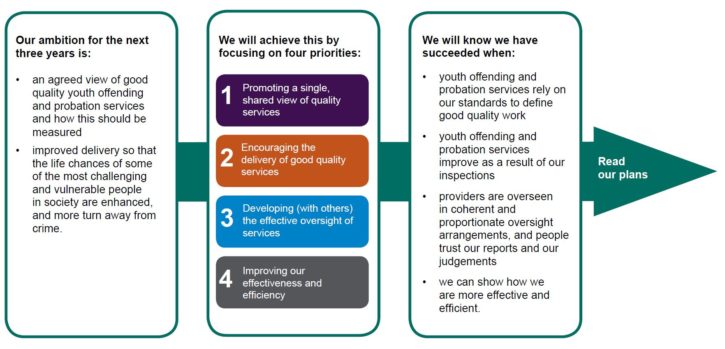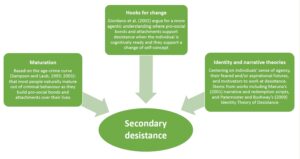Mapping a new direction
I summarise and share a lot of information on this blog — the latest policy announcements, research, examples of effective practice and innovation — but I draw the line at corporate reports. This is because, on the whole, they are both inward facing and dull as ditch water.
But the new HM Inspectorate of Probation corporate plan for 2017-2020 has proved an exception.
Mercifully short and surprisingly jargon-free and easy to read, it sets out an important new direction for HMI Probation.
Rating probation services
As regular readers know, HMI Probation has become an increasingly important institution in the aftermath of the government’s partial privatisation of the probation service via its Transforming Rehabilitation (TR) project. The inspectorate has conducted a dozen inspections of public and private probation (National Probation Service and Community Rehabilitation Company) based on Police/Police and Crime Commissioner areas — almost all of which have found the CRCs in particular to be performing poorly. Many in the probation world have been pleased that the Chief Inspector, Dame Glenys Stacey, has been prepared to be blunt in her criticisms; stating that supervision by telephone is not acceptable and that new through-the-gate arrangements are having “no impact”.
The greater prominence of the Inspectorate has led to some criticism of its approach; the main ones being:
- The inspection process is too slow — there is too long a gap between inspections of the same area, especially at a time when the pace of change post-TR is rapid.
- The number of cases on which inspections are based is rather low allowing questions to be raised about the robustness and reliability of inspectors’ judgments.
- The process of inspection can be draining on NPS and CRC resources, particularly the latter where the same CRC may be inspected several times since it can comprise as many as four PCC areas.
The corporate plan addresses all of these issues and maps out a clear forward direction:
- HMIP is developing a national framework for probation standards and will work with commissioners, providers,
probation professionals, service users to agree quality indicators that will flesh out what good probation practice looks like. - HMIP will inspect all probation services annually and inspect CRCs and NPS divisions separately.
- Critically, HMIP will introducing a rating system and grade probation areas to make them more directly comparable (in the same way as the CQC grades care homes and Ofsted assesses schools). Expect a rating system of the Outstanding, Good, Requires Improvement, Inadequate type.
- HMIP will include probation work done in prison as part of its area inspections.
- HMIP will reduce the burden on providers by using data and information available from providers and HMPPS, so
that as far as possible, providers are only asked for information once.

Promoting quality
Hearteningly, the purpose of this overhaul is to encourage the delivery of good quality services and the Inspectorate has been talking to the Ministry of Justice to work out how gaining a decent rating from HMI Probation can be incentivised. Presumably these discussions were part of the probation review which I understood to have been more or less ready for publication when the general election got in the way (as it did quite fundamentally for prison reform).
The corporate plan makes it clear that HMIP has secured the extra resources needed for this expansion of its role and that it will be developing standards and new inspection methodologies this year, ready to implement its new approach in Spring 2018.
Conclusion
I have to declare that I am slightly more than an interested bystander as I am a member of the HMI Probation Advisory Group, but I am very heartened by the new approach which, in my opinion, will hold up local probation services to a more rigorous scrutiny and, hopefully, drive many of them to improve current poor practice.
As the corporate plan says, the goal of the new approach is that probation services improve as a result of HMIP inspections:










2 Responses
Dame Glenys’s reports have been a beacon of transparency and honesty in the post-TR fog. If this is being recognised and strengthened all who care about probation standards will welcome this. Yet there is much work to do to translate these aspirations into reality with engaging staff and strengthening their confidence critical. Napo have been pushing for clear, across probation professional standards since before TR and now see aligning these with the introduction of a license to practice and pay reform as critical pillars to stabilise the service. But most critically these must be developed in dialogue with probation staff – the only glue still holding things together.
Thanks Dean, a very helpful and constructive piece of feedback. Do you see a role for the Probation Institute too?